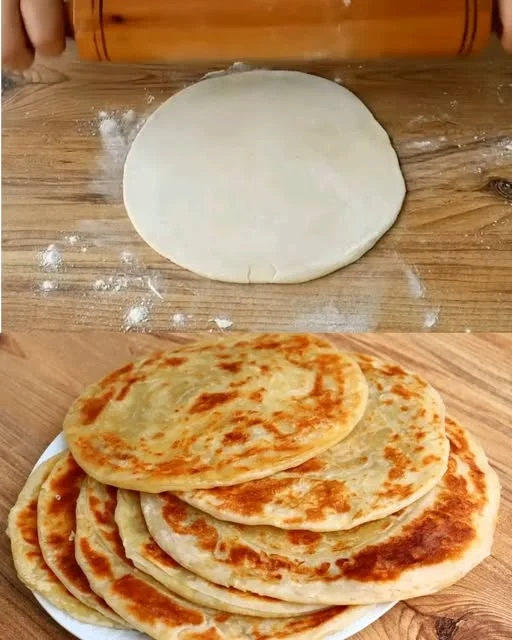It’s often the simplest recipes that hold the most meaning in our kitchens. I remember my grandmother making this dough when I was younger—a recipe so easy, yet always producing the most delightful, flaky results. It was one of those recipes that didn’t require much fuss but never failed to create the perfect pastry or pie crust. She would hum as she worked the dough, never once needing a recipe card, and I remember her saying, “Sometimes, the best things are the ones that come together the quickest.”
This dough recipe became a staple in our home, passed down through generations, and it has always been my go-to when I need something quick and reliable. Over the years, I’ve come to appreciate the beauty of a simple, unpretentious dough that can elevate even the most basic of ingredients into something truly special. Whether it was a flaky pie crust for a sweet apple pie or delicate pastries filled with cream and fruit, this dough never let me down.
What I love about it is its versatility. The same dough can be used for everything from savory pies to buttery biscuits, or even a base for a galette. The beauty lies in its simplicity, and the fact that you can always have the ingredients on hand to make it quickly whenever you need a comforting homemade dish.
Why This Dough Works So Well
At first glance, this recipe might seem like a basic dough, but what makes it stand out is the balance of ingredients and technique. The proportions are key: just the right amount of butter to flour creates a delicate, melt-in-your-mouth texture, while the water helps bind the dough without making it overly sticky. The salt enhances the natural flavors and brings out the richness of the butter, which is the heart of any good dough.
Unlike other doughs that require a long resting period or complex instructions, this recipe is straightforward and efficient. In about 30 minutes, you can have dough that is perfectly chilled and ready to be rolled out into whatever form you need—whether that’s a buttery crust for a tart, a flaky top for a savory pot pie, or even pastry twists for an afternoon snack.
Ingredients
| Ingredient | Amount |
|---|---|
| White flour | Less than 4 cups (about 410 g) |
| Water | 1.5 cups (about 300 ml) |
| Salt | 1 teaspoon (about 6 g) |
| Butter | 160 g |
Directions:
- Mix Dry Ingredients: In a large bowl, combine the white flour and salt. Stir until evenly mixed.
- Add Butter: Cut the cold butter into small cubes and add it to the flour mixture. Use your fingers or a pastry cutter to work the butter into the flour until it resembles coarse crumbs.
- Add Water: Gradually add the water, a little at a time, stirring until the dough begins to come together. Add just enough water for the dough to form, but not too much that it becomes sticky.
- Form the Dough: Turn the dough out onto a lightly floured surface. Gently knead the dough a few times until smooth, being careful not to overwork it.
- Rest the Dough: Wrap the dough in plastic wrap and let it rest in the refrigerator for at least 30 minutes before using. This helps to relax the dough and makes it easier to roll out.
Nutritional Information (per serving):
| Nutrient | Amount |
|---|---|
| Calories | 320 |
| Fat | 20g |
| Carbohydrates | 33g |
| Protein | 4g |
| Fiber | 2g |
Why You Should Try This Recipe
There are so many reasons why this dough should become your go-to in the kitchen. Here are a few key points:
- Quick and Easy:
In less than an hour (including resting time), you can have dough that’s ready to use, making it ideal for those moments when you need something fast but still want a homemade touch. - Versatile:
This dough is incredibly versatile. Use it for both sweet and savory dishes. Whether you’re making fruit pies, quiches, or savory pastries, this dough serves as a perfect base. - Few Ingredients, Big Flavor:
With only four basic ingredients, this dough is simple yet delivers on taste. The butter provides the perfect richness, while the flour ensures a delicate texture. The salt ties everything together for that irresistible flavor balance. - Perfect Every Time:
This recipe is reliable. Even if you’ve never made dough before, it’s hard to go wrong. The butter and flour are easily worked together, and the water binds it all into a smooth dough that rolls out beautifully.
Frequently Asked Questions (FAQs)
1. Can I use this dough for both sweet and savory recipes?
Yes, absolutely! This dough is very versatile. For savory recipes, like pot pies or quiches, you can simply add your desired fillings after rolling out the dough. For sweet pies or tarts, like apple pie or lemon meringue, it works wonderfully when you add a sweet filling to balance its natural richness.
2. Can I use a food processor to make the dough?
Definitely! If you want to save time, you can use a food processor to cut the butter into the flour. Just pulse the ingredients until the mixture resembles coarse crumbs, then add the water and pulse again until the dough starts to come together. Once the dough is ready, follow the rest of the instructions as usual.
3. Can I freeze this dough?
Yes, this dough freezes well! If you’re not using it immediately, wrap it tightly in plastic wrap or place it in an airtight container and freeze it for up to three months. When you’re ready to use it, let it thaw in the refrigerator overnight. You’ll find that the dough works just as well after freezing!
4. What type of butter should I use?
For the best results, use cold unsalted butter. Cold butter is key to achieving the flaky texture that makes this dough so delicious. You can use salted butter, but you may want to adjust the amount of salt added to the dough to avoid it becoming too salty.
5. Can I make this dough without a mixer or food processor?
Yes! The beauty of this dough is that it can be made entirely by hand. Simply cut the cold butter into the flour using a pastry cutter or your fingers until the mixture resembles coarse crumbs. Then add the water and mix until the dough comes together. It’s a very hands-on process that doesn’t require any special tools, just a little elbow grease!
6. Can I use a gluten-free flour substitute?
Yes, you can use a gluten-free all-purpose flour blend as a substitute for the regular white flour in this recipe. Make sure to check that the gluten-free flour blend includes xanthan gum or another binder, which will help the dough hold together. The texture may vary slightly, but it should still work well for most recipes.
7. How thick should I roll the dough?
For most recipes, rolling the dough to about 1/8 inch thick is ideal. This will give you a nice balance between flakiness and structure. However, if you’re making a thick pie or need a more substantial crust, you can roll it thicker.
Additional Tips for Success
- Cold Ingredients Are Key:
The secret to flaky dough is keeping everything cold—especially the butter. Cold butter doesn’t fully integrate into the flour, creating pockets of butter that will melt during baking, leaving behind layers that puff up beautifully. Refrigerate the dough before rolling it out to ensure it’s cold and easy to work with. - Don’t Overwork the Dough:
When making dough, less is more. Overworking the dough will cause it to become tough and lose its flakiness. Knead it just enough to bring it together, then chill it before rolling out. - Chill the Dough:
After mixing and forming the dough, it’s important to let it chill for at least 30 minutes. This allows the gluten to relax, making the dough easier to roll and helping it maintain its structure during baking.
Conclusion: The Recipe for Success
In the hustle and bustle of everyday life, it’s easy to forget the simple joys that come from creating something with your own hands. This quick, flaky dough recipe is a perfect reminder of that. It doesn’t require hours of preparation, and the ingredients are so basic that you can always have them on hand. Yet, the end result is something truly delightful—whether you’re using it for a savory dish or a sweet treat.
The next time you find yourself in need of a quick and reliable dough, remember this recipe. It’s a true kitchen staple, offering you the freedom to get creative with your cooking while still achieving perfect results every time. After all, sometimes the simplest recipes, those that come together the quickest, are the ones that make the most lasting memories.

Quick and Delicious: Perfect Flaky Dough
Ingredients
Method
- Prepare the Dry Ingredients: In a large mixing bowl, combine the flour and salt. Stir to evenly distribute the salt throughout the flour.
- Incorporate the Butter: Cut the cold butter into small cubes and add them to the flour mixture. Use your fingers or a pastry cutter to work the butter into the flour until it forms coarse crumbs.
- Add Water: Gradually pour the water into the mixture, stirring as you go. Add enough water to form a dough. Avoid making it too sticky—just enough to bind the ingredients together.
- Knead the Dough: Turn the dough out onto a lightly floured surface. Gently knead it a few times to bring it together. Do not overwork the dough, as that could affect its flakiness.
- Rest the Dough: Wrap the dough in plastic wrap and let it rest in the refrigerator for at least 30 minutes before using. This resting time allows the dough to firm up and become easier to roll out.
Notes
- Freezing: This dough can be frozen for up to three months. Wrap it tightly in plastic wrap and store it in an airtight container or freezer bag. Thaw in the refrigerator overnight before use.
- For Sweet Dishes: Add a little sugar to the dough for a sweeter base, perfect for fruit tarts or pastries.
- Butter: Cold butter is key to getting that flaky, buttery texture. Always use unsalted butter for more control over the seasoning.

